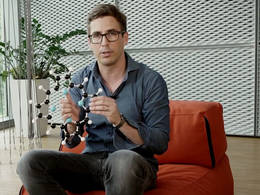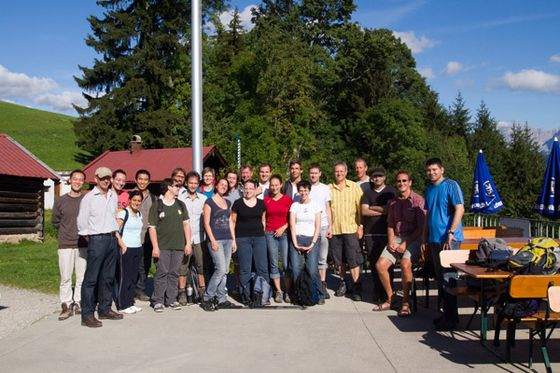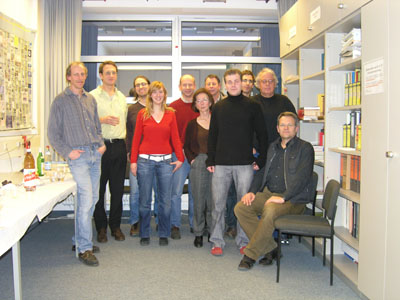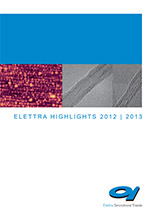Aktuelles
Bachelor-, Master-, und Doktorarbeiten:
PhD Position “Surface Chemical Physics and Molecular Nanoscience” (Department of Physics)
Master project: Foldamers on solid surfaces: tethering, folding and assembly
16.01.2020 - Complex, porous, chiral nano-patterns arise from a simple linear building block

read more: TUM news
29.10.2018 - 2D-Ink (FET-Open)
24.05.2018 - Switching with molecules

Molecular switch will facilitate the development of pioneering electro-optical devices
A research team led by physicists at the Technical University of Munich (TUM) has developed molecular nanoswitches that can be toggled between two structurally different states using an applied voltage. They can serve as the basis for a pioneering class of devices that could replace silicon-based components with organic molecules.
read more: TUM news
22.01.2018 - Complex tessellations, extraordinary materials

An international team of researchers lead by the Physics Department at TUM has discovered a reaction path that produces exotic layers with semiregular structures. These kinds of materials are interesting because they frequently possess extraordinary properties. In the process, simple organic molecules are converted to larger units which form the complex, semiregular patterns.
read more: TUM news
20.09.2016 - Scientists pair up two stars from the world of chemistry

Many scientists consider graphene to be a wonder material. Now, a team of researchers at the Technical University of Munich (TUM) has succeeded in linking graphene with another important chemical group, the porphyrins. Porphyrins are well-known because of their striking functional properties which for example play a central role in chlorophyll during photosynthesis. These new hybrid structures could also be used in the field of molecular electronics, catalysis or even as sensors.
read more: TUM News
13.07.2016 - New materials for the construction of metal organic two-dimensional quasicrystals

Unlike classical crystals, quasicrystals do not comprise periodic units, even though they do have a superordinate structure. The formation of the fascinating mosaics that they produce is barely understood. In the context of an international collaborative effort, researchers at the Technical University of Munich (TUM) have now presented a methodology that allows the production of two-dimensional quasicrystals from metal organic networks, opening the door to the development of promising new materials.
read more: TUM News
TheProject 2D-INK receives 3 million € from the EU
The European project 2D-INK has received 2,962,661 € of funding from the EU Framework Programme for Research and Innovation Horizon 2020 as a Future and Emerging Technologies Action (FET Open).
2D-INK is targeted at developing inks of novel 2D semiconducting materials for low-cost large-area fabrication processes, which will exceed the properties of state-of-the-art graphene- and graphene oxide based inks. These semiconductive inks will provide the key parameters for fabricating the next generation of ultrathin electronic appliances (such as transistors, LEDs, and solar cells) using the same technology of current inkjet printers.
2D-INK will be developed by a strongly interdisciplinary research team composed of 9 partners: POLYMAT, University of the Basque Country (Spain), Algoritmi Center, Universidade do Minho (Portugal); ICMol, Universitat de Valencia (Spain); the Technische Universität München (Germany); the Katholieke Universiteit Leuven (Belgium); the Universität Wien (Austria); the University of Nottingham (United Kingdom), CIC NanoGUNE (Spain), and the company Graphenea (Spain).
Our group will contribute the expertise in surface and nanoscale characterization by employing a battery of state-of-the-art techniques, notably including temperature-controlled scanning tunneling probe microscopy and spectroscopy as well as Xray spectroscopies.
The FET-OPEN (Future and Emerging Technologies) projects of the European Union support research lines in early stages, based on ideas that may arise new technology lines. Thus, the EU initiative encourages scientists and engineers from many disciplines to cooperate in research projects that promote scientific progress. It is noteworthy, too, that the European program FET -OPEN is a highly competitive call: only 24 of the 643 submitted projects (3.7%) have been funded across Europe.
PATENTS
The development of semiconductor inks from two-dimensional materials with different properties represent, according to the members of the consortium, "a major breakthrough in the field of new materials for the next generation of ultra-thin electronic devices such as transistors, LEDs, solar cells, protodetectors, etc.". The researchers also foresee the submission of patents, given the technological possibilities of 2D-INK and the involvement of a private company.
Wilhelm Auwärter appointed W2 Professor

We proudly announce that our member Wilhelm Auwärter was appointed Assistant Professor on 1 April 2015.
The research focus of Professor Auwärter (b.1973) lies on the creation of nanoscale model systems on atomically tailored surfaces, enabling the study and control of single-molecule processes as well as the self-assembly of supramolecular structures.

Surface Science issue 635 - Cover page image
to see the full article:
26.2.2015 - Caging of molecules allows investigation of equilibrium thermodynamics

Moving molecules write letters
High performance materials for gas storage, thermal insulators or nanomachines need a thorough understanding of the behavior of the material down to the molecular level. Thermodynamics, which have been developed two hundred years ago to increase the efficiency of steam engines, typically observes and averages over a large number of molecules. Now a team of scientists has developed a methodology, to investigate the equilibrium thermodynamics of single molecules.
read more: TUM News
17. Sept. 2014 Wanderung auf den Stümpfling


13.8.2014 - Flexible tapes from the nanoworld
Dr. Wilhelm Auwärter and his team are working on a research project to develop tiny flat molecule tapes at the Department of Physics of Technische Universität München (TUM). These structures could find versatile applications. Via direct coupling on a silver surface, the scientists successfully formed dimers and short chains of porphine molecules without contaminating by-products.
read more: TUM news
28.1.2014 - Artikel in ACS Nano, Iss.1, 2014
Self-Assembly and Chemical Modifications of Bisphenol A on Cu(111): Interplay Between Ordering and Thermally Activated Stepwise Deprotonation
Scanning tunneling microscopy images of the patterns formed by the self-assembly of Bishphenol A molecules on an atomically flat Cu(111) surface. The bright protrusions correspond to single molecules. The assembly is subjected to a series of thermally activated irreversible transitions which correlate to alterations of the chemical state of the molecules.
11.12.2013 - Artikel in "Elettra Top Stories"
Interfacial complexation reactions in vacuo: a self-terminating protocol via metal-organic chemical vapor deposition
The engineering of coordination complexes and metal-organic architectures at well-defined interfaces holds great promise in important research areas such as single-site catalysis and molecular magnetism. Here the ability to incorporate metal centers in unique coordination environments can convey specific functionalities to tailor the physical and chemical properties. Usually, such systems are prepared in vacuo by grafting prefabricated metal-organic complexes on surfaces or by co-deposition of molecular linkers and metal adatoms followed by complexation reactions. In the case of transition metals such as W, Ru and Ir, the latter method can be severely limited by the high sublimation temperature of these materials, whereas the former relies on the availability of established organic synthesis protocols. This prompted us to investigate an alternative pathway based on metal-organic chemical vapor deposition, exemplified here by the reaction of porphyrins with a ruthenium carbonyl precursor, Ru, on the Ag(111) surface. Our experiments were based on X-ray photoelectron spectroscopy (XPS) and complementary Near Edge Absorption Fine Structure (NEXAFS) with synchrotron radiation and were performed at the Materials Science Beamline. Additional support was provided by scanning tunneling microscopy (STM) measurements carried out at the Technische Universität München.
link to "Elettra top stories"
"Elettra Highlights 2012/2013", page 58-59 as PDF
8.8.2013 - Molecules form 2-D patterns never before observed
Nanoscience experiments produce elusive 5-vertex tilings
Tessellation patterns that have fascinated mathematicians since Johannes Kepler worked out their systematics 400 years ago – and that more recently have caught the eye of both artists and crystallographers – can now be seen in the laboratory. They first took shape on a surface more perfectly two-dimensional than any sheet of writing paper, a single layer of atoms and molecules atop an atomically smooth substrate. Physicists coaxed these so-called Kepler tilings "onto the page" through guided self-assembly of nanostructures.
The experiments were carried out by postdoctoral researcher David Ecija, PhD candidate Jose Ignacio Urgel and colleagues in the Physics Department of Technische Universitaet Muenchen (TUM), in collaboration with scientists in Karlsruhe and Zurich. They reported their findings in the Proceedings of the National Academy of Sciences.
6.12.2012 - Lichtpulse steuern elektrische Signale:

10000 mal schneller als elektronische Transistoren
Bis zu 100 Milliarden Schaltvorgänge können heutige Transistoren aus Silizium in einer Sekunde ausführen. Münchener Wissenschaftler zeigten nun in zwei Grundlagenexperimenten, dass mit Hilfe extrem kurzer Laserpulse moderater Energie auch nichtleitende Materialien für solche Schaltvorgänge genutzt werden könnten. Damit wären etwa 10.000 mal schnellere Schaltfrequenzen realisierbar.
23.11.2012 - Artikel in "Physical Chemistry Chemical Physics"
"Nature of the attractive interaction between proton acceptors and organic ring systems"
highlighted as cover article for "PCCP, Vol 14, Nr. 46, 14.Dez.2012".
Wenn sich auf molekularer Ebene biologische Strukturen organisieren oder künstliche Architekturen entstehen spielen nichtkovalente Wechselwirkungen, wie zum Beispiel Wasserstoffbrücken, zwischen speziellen funktionellen Gruppen eine wichtige Rolle. Die häufig auftretende Anziehung von funktionellen Molekülen, die gerne Wasserstoffbrücken eingehen, zu aromatischen Ringen wurde intensiv untersucht und gemeinhin als Wasserstoffbrücke mit stark lokalem Bindungscharakter eingegliedert. Jetzt führten Dr. E. Arras, Dr. F. Klappenberger und Prof. J. V. Barth (E20, TUM) zusammen mit dem Theoretiker Dr. A. P. Seitsonen (Univ. Zürich) eine erneute theoretische Analyse mit einem veränderten Blickwinkel durch. Diese zeigte, dass die Anziehung andere Ursachen hat als bisher angenommen, und insbesondere durch Beiträge des ganzen aromatischen Rings geprägt ist, womit sich frühere Interpretationen als irreführend herausstellen. Die veränderte Interpretation trägt wesentlich dazu bei, das komplexe Zusammenspiel der Wechselwirkungen bei molekularen Erkennungsphänomenen in entsprechenden synthetischen und biologischen Systemen besser zu verstehen.
31.10.2012 – Gaede-Langmuir Award für Prof. emeritus Dr. Dietrich Menzel
Dietrich Menzel, emeritierter Professor des Physik-Departments, ist am 31. Oktober von der American Vacuum Society (AVS) mit dem Gaede-Langmuir-Preis geehrt worden. Die AVS würdigt damit Prof. Menzels “ground breaking and sustained contributions towards a comprehensive understanding of the energy transfer processes influencing the physical and chemical behavior of atomic and molecular species on metal surfaces”.
1.10.2012 Einzelner Proteinkomplex erzeugt Strom

Solarzelle aus einem Molekül
Ein Team der Technischen Universität München, geleitet von Joachim Reichert, Johannes Barth (Exzellenzcluster MAP) und Alexander Holleitner (Exzellenzcluster NIM) hat in Kooperation mit Itai Carmeli (Tel Aviv University) eine Methode entwickelt, um den Photostrom eines einzelnen Moleküls zu messen. Die Physiker konnten zeigen, dass ein einzelnes Photosystem-Protein als Baustein in photoaktive Nanoschaltkreise integriert und direkt angesteuert werden kann. Dabei behält das Protein seine optischen Eigenschaften. Es fungiert als lichtgetriebene hocheffiziente Elektronenpumpe und kann als Stromgenerator in winzigen elektrischen Bauelementen dienen.
11.12.2011 Gezielter Protonentransfer in einem Molekül, der kleinste mögliche Schalter
Pressemitteilung der TUM und der Physik
Miniaturisierung ist seit langem das Zauberwort in der Elektronik. Ins Extreme getrieben hat sie jetzt ein Physikerteam um Dr. Willi Auwärter und Professor Johannes Barth von der Technischen Universität München (TUM), die in der Publikation „Nature Nanotechnology“ einen neuartigen molekularen Schalter vorstellen. Entscheidend für die Funktionsweise des Schalters ist die Position eines einzelnen Protons in einem Porphyrinring mit einem Innendurchmesser von weniger als einem halben Nanometer. Vier unterschiedliche Zustände können die Wissenschaftler hier gezielt einstellen.
Publikationsliste, Paper

13. Sep. 2011 E20 Bergwanderung über die Partnachklamm hoch zum Eckbauer

Apr. 2011 , Artikel in "Advanced Functional Materials ":
"Surface Chemistry: Surface-Confined Self-Assembly of Di-carbonitrile Polyphenyls"
STM images of random 2D disordered, glassy coordination networks chosen as Frontispiece of Advanced Funtional Materials, 7th issue of april 2011.
The reproduced STM image reveals a random metal-organic coordination network. The metal-directed assembly was induced by cobalt centers engaging in lateral metal–ligand interactions with the ditopic linker that is nonlinear, prochiral, and bears terminal carbonitrile groups on the Ag(111) substrate. This work represents a first example of a novel strategy in constructing metal-organic materials: the divergent coordination assembly.

Feb. 2011, Artikel in "nature chemistry":
"Cis-dicarbonyl binding at cobalt and iron porphyrins with saddle-shape conformation"
highlighted as title for nature chemistry feb. 2011.
Metalloporphyrins have a variety of roles in nature, including catalysis and the transport of respiratory gases, and many of these involve the binding of diatomic molecules. Now, the interaction of carbon monoxide with simple iron- and cobalt-porphyrins has been studied at the single-molecule level, revealing a surprising binding scheme.
Nov. 2010, Artikel in "Proceedings of the National Academy of Sciences of the USA ":
"Rotational and constitutional dynamics of caged supramolecules", {pdf} supporting information
Wissenschaftlern des Lehrstuhls E20 an der Technischen Universität München (TUM) ist es gelungen, stabförmige Moleküle dazu zu bringen, sich selbst zu nur wenige Nanometer großen Rotoren zusammen zu setzen. Die winzigen Systeme dienen der Untersuchung der Kräfte, denen Moleküle auf Oberflächen und in Käfigen ausgesetzt sind.

6. Okt. 2010 - E20 Bergwanderung auf das Brauneck
Johannes Barth receives European Research Council Advanced Grant.
The 2.6 MioEUR award from the European Research Council will support research on molecular nano-architectures for a period of five years. A key issue is the comprehension of metal-ligand interactions at surfaces and their use for the rational design of functional nanosystems. The multidisciplinary studies will be performed by E20 team members in close cooperation with Dr. Mario Ruben (Karlsruhe Institute of Technology) and Dr. A.P. Seitsonen (Universität. Zürich).

1 Artikel im Journal of Physics: Condensed Matter Top Papers of 2008
Journal of Physics: Condensed Matter Top Papers of 2008 , Abstract, {pdf}
E20 Wanderung am 5. Okt. 2009 - Wanderung vom Schliersee zum Tegernsee

März 2009, Neuer Artikel:
"Supramolecular control of the magnetic anisotropy in two-dimensional high-spin Fe arrays at a metal interface"
highlighted as title for Nature Materials.
This study demonstrate how control over magnetic centers in coordination complexes on surfaces may lead to new spintronics applications.
See also News & Views statement in Nature Mat..
14 Oct. 2008 Hans Fischer Senior IAS Fellowship for Professor Douglas BONN
The Technische Universität München, Institute for Advanced Study has awarded a Hans Fischer Senior Fellowship to Professor Douglas BONN from the Physics Department at The University of Britisch Columbia in recognition of his excellence in solid state physics and in anticipation of innovative research projects in nascent areas with breaktrough potential. This award fellowship is donated with a total sum of 160.000 € and 2 stipends for PhD students for the coming 3 years. With this support a joint project between the TUM Physics Chair E20 (Prof. J.V. BARTH) and Prof. BONN is launched in the area of Nanoscale Control of Quantum Materials. This project is part of the IAS Focus Area in Nanoscale Science. Prof. BONN will spend a sabbatical in 2009 as visiting professor at Physik Department E20, TUM. Two PhD students will perform their research at the partner institutions in joint projects.
Freitag, 12.12.2008: Symposium anlässlich des 60. Geburtstags von Herrn Dr. habil. Peter Feulner
Artikel:
"Chiral kagome lattice from simple ditopic molecular bricks" highlighted in Materials Today
Simple building blocks show a complex side Polymers and Soft Materials {pdf}
E20 Wanderung am 8. Okt. 2008 - Wanderung um den Tegernsee
E20 Bergtour am 11. Okt. 2007 - Wanderung auf die Rotwand im Schlierseegebiet
Oct-10-2007
Nobel prize in chemistry honours Prof. G. Ertl for his studies
of chemical processes on solid surfaces
Further information :
TUM Pressemitteilung
BBC News
Spiegel online
Sueddeutsche Zeitung online - video
TU München
Münchner Merkur - Reaktionen
Le Monde - video
Le Monde article
Gerhard Ertl Festschrift: The Journal of Physical Chemistry B , Vol. 108, Iss. 38 Publication: G. Ertl's highest impact STM paper on the Au(111) surface reconstruction with rescanned images from original data Phys. Rev. B 42, 9307 (1990)
Feb-1-2007 - E20 group photo of the very beginning






